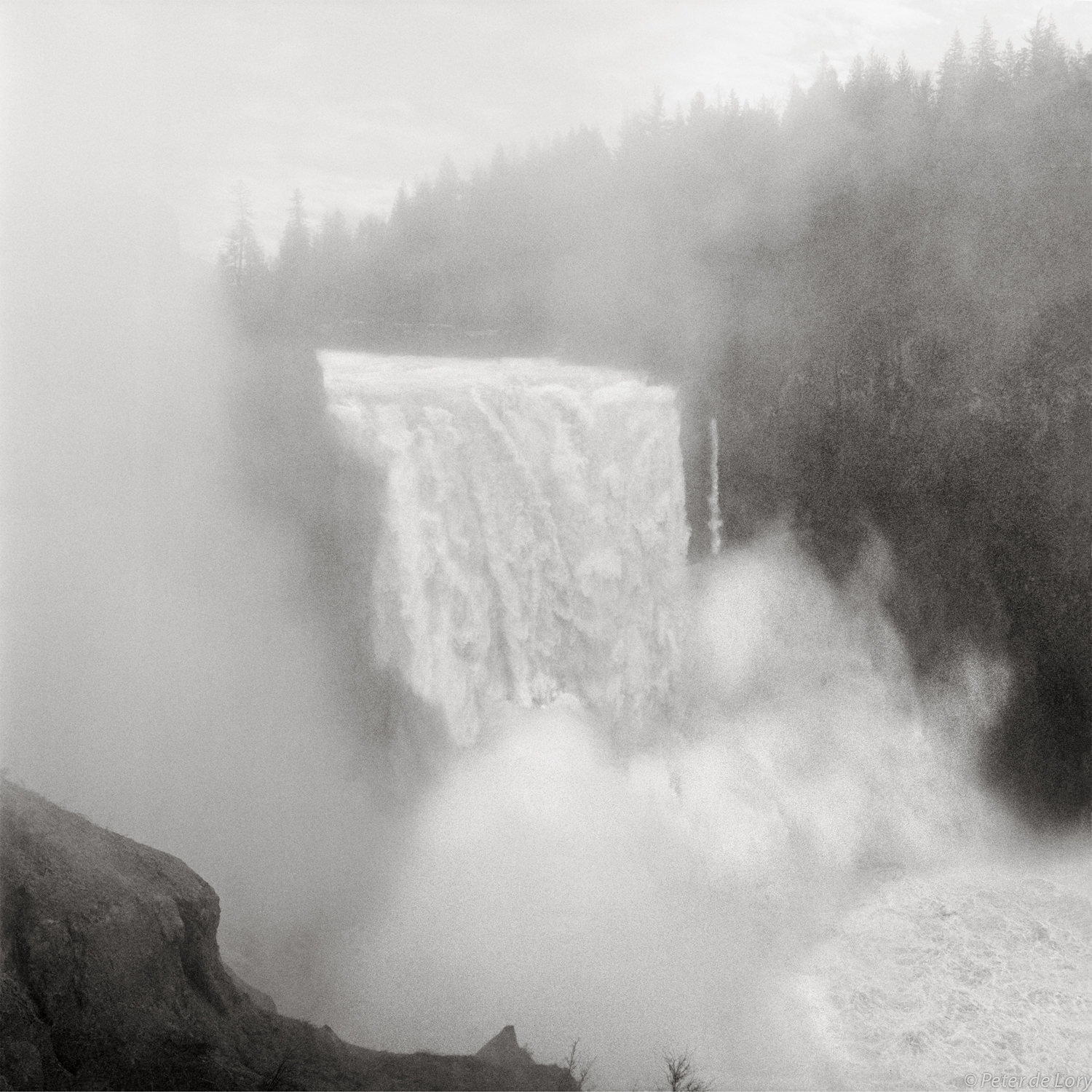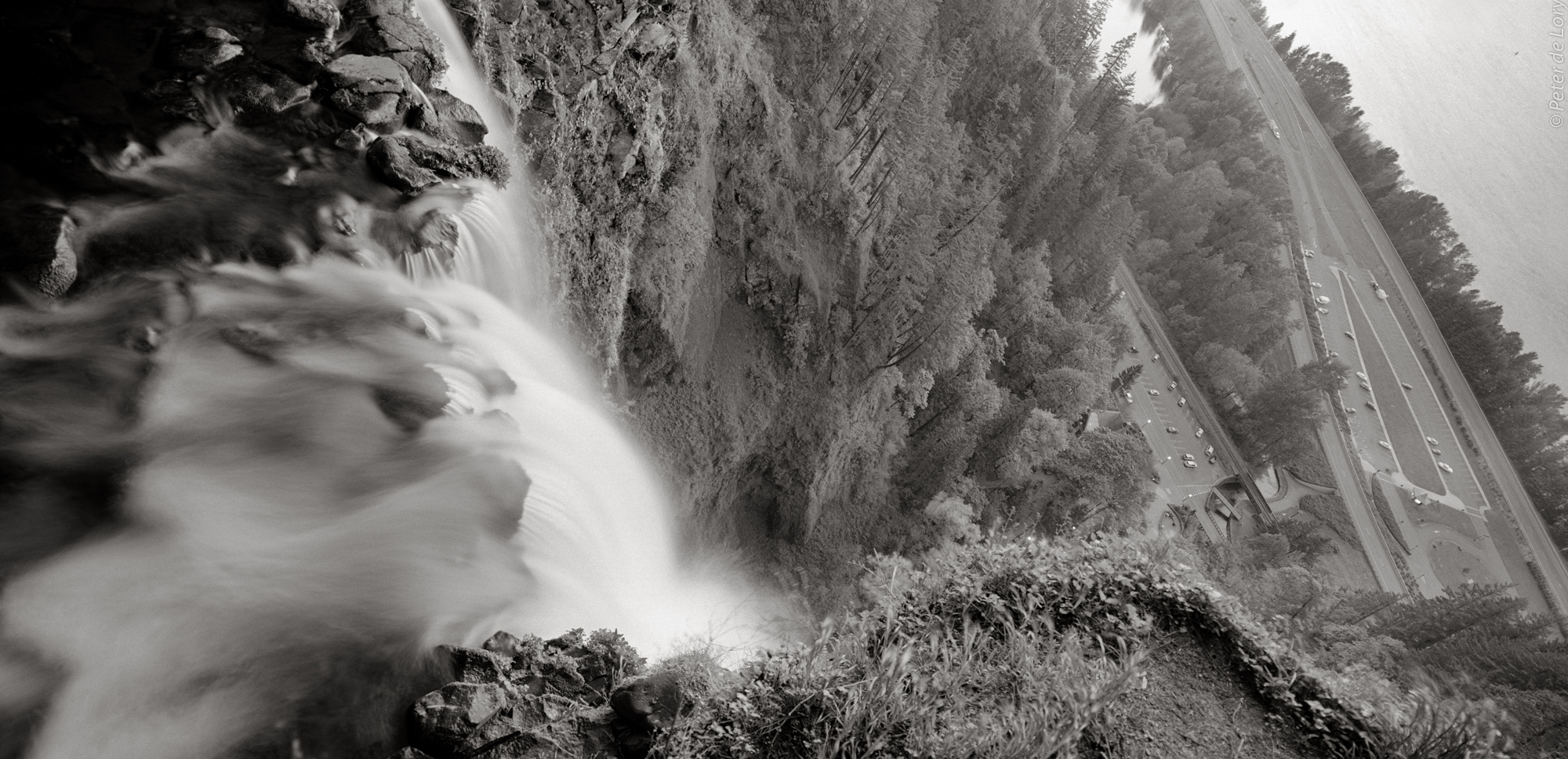
The Falls
No dream life is complete without the dreams of flying. And, while the ascent and glide-soar of the dream is a loss beyond measure upon waking, the waking is necessary to complete the arc of flight. The narrative is completed by wonder: wonder that it happened, that it was possible, and that the flying self was so perfectly understood by the gravity-bound self. As if we are always wait- ing to take wing; as if a deep part of ourselves was shaped by its relationship to ascension and sky. When we wake, we are returned to gravity and become more stone than feather, more plunge than rise, more body than dream.
Peter de Lory's photographs of waterfalls give us both worlds simultane-ously: the float and the plunge, the dream and the waking. In his images, onlook-ers turn their backs to the outer world and enter the interior dream shaped by falling water, and are trapped for a moment in the eternality of falling. To turn away from the falls is to enter the waking life again.
I believe it is the waterfall's eternal descent that holds us in its grip as witnesses to a dream. In several of Peter de Lory's waterfall photographs, the whole-body devotion of the onlooker to the falls experience is dominant. The blind man faces the falls directly, opens himself to the approach and their presence. It is fortunate that the falls are hardly just about seeing. The water's spray, its channel downdraft of cold—confrontational and alluring, columnar and alive—calls onlookers closer, and the only answer is approach. Once there, they face it, gathering in groups as if to bolster against the same story we all fear: we dream alone, we wake alone, we fall alone. Our own bodies are enough water to hear the message of descent register in each of the billions-cell centers of our selves. It is impossible not to approach a fall.
De Lory's falls present a pull to wide-open wonder. The water cannot be contained; the soft spray edges of them are almost more smoke than water. And the experience, like smoke, is as ephemeral. The power of the images exists in the presence of the now-moment, pull-spot of proximity, and grips viewers in an awareness of the fall and the gravity that receives it.
It is no wonder some of the couples captured by de Lory have turned their backs to the waterfall in front of which they pose. If the waterfall holds a reminder of the constancy with which mortality works away at us, and of the end of the dream, then let them turn away while they are still arm in arm. Behind them rushes the dream world into which they will stare when they need something to share between them when the other world is failing. In front of them, their backs to the fall, stands the world of their conscious making—a world to pose within because it is a world at their command. But behind them, the descent forever pulls more of itself after it, a constancy of down and down, a forever rushing away from what seems an impossible source of plenty. The waterfall declares itself in a long exclamation of freefall, then churns a pool and pushes forth a river, passing over the earth and away seemingly without end. But there is an end.
It is no wonder the image of the children playing in the pools at the bottom of the falls is so poignant. If the flight of our dreams were a body of water, it would be a waterfall. Our waking is the pool at its end, catching moments that cannot be sustained. The children play, unaware that time has already memorized their faces, and that the pool they play in is the end of flight.
I love most the photographs in which people allow their entire bodies to receive the sound and rush of water falling through the vast stretch of air. In turning, they become receivers to the water's transmission. I think it is this desire to be in the realm of the continuously transformative that pulls us to approach the falls, to get a little closer, to make waterfalls a destination.
The iconic American falls captured by de Lory speak to the part of us we want to be sure lives fully and in the beautiful moment of suspension before the inevitable descent. Though the pools at the bottom churn with the acceptance of more than themselves, a stillness persists, a meditation on falling water. But that too is broken soon enough, and the people return to their cars and homes. They understand the lesson: if we keep moving, time might pardon us, forget how we sit like a stone at the edge of its cliff, poised to fly before the freefall plunge into light and the memory of absence.
— Jennifer Boyden
Writer Jennifer Boyden lives in eastern Washington. Her book The Mouths of Grazing Things was awarded the Brittingham Prize in Poetry (2010).

Couple Listening to Yosemite Falls, CA, 2,425 ft., 1990

Palouse Falls in Moonlight, WA, 185 ft. plunge, 2009

Below Palouse Falls, WA, 185 ft. plunge, 2009

Snoqualmie Falls, WA, 268 ft. plunge, 2009

Snoqualmie Falls, WA, 268 ft. plunge, 2010

Lower Elk Falls, ID, 90ft. plunge, 2010

Lower Elk Falls, ID, 90ft. plunge, 2010

Family at Shoshone Falls, ID, 212 ft. plunge, 2009

Rifle Falls, Rifle CO, 2013

Below Rifle Falls, Rifle CO, 2013

A Couple at Rainbow Falls, Manitou Springs CO, 2012

Franklin Falls, under Interstate 5, Snoqualmie Pass, WA, 2011

Australian Shepherds at Yellow Dog Falls, Michigan Upper Peninsula, 2013

Woman with a Goat, Calf Creek Falls, UT 125 ft. plunge, 2010

Tulauip Casino, WA, 2001

Casablanca Casino, NV, 2011

Tumwater Falls at Old Olympia Brewery, Tumwater, WA, 2013

Lava Falls, near Mt.Rainier, WA, 2012

Under Perrine Coulee Falls, ID, 195 ft., plunge 2010

Christine Falls, WA, 50 ft. plunge, 2009

Lower Punch Bowl Falls, Columbia River Gorge, OR, 2010

Under Latourell Falls, Columbia River Gorge, OR 249 ft. plunge, 2009

Rock Cairn, The Gorge, WA, 2010

Top of Multnomah Falls, OR, 620 ft , 2009

Multnomah Falls in Twilight, OR, 620 ft , 2009

Ponytail Falls, OR,125 ft. plunge, 2010

Latourell Falls OR, 249ft. plunge, 2009

Comet Falls, Mt. Rainier, WA, 320 ft. plunge, 2013

Narada Falls WA,168 ft. plunge, 2010

Perrine Coulee Falls, ID, 195 ft., plunge 2010,

Calf Creek Falls, UT, 125.ft plunge, 2010

Wallace Falls, WA, 260ft. 2009

Comet Falls, Mt. Rainier, WA, 426 ft. plunge – multiple falls, 2013

Twin Falls, OR, 150ft. plummet, 2010

The Wall of Water Falls, 2009-2010


Musing The Falls, 2009-2013

Musing at Multnomah Falls, 2009-2013

Linville Falls, NC. 45ft. 1987

Lower Yellowstone Falls, 308ft. WY. 2013

Dry Falls, 400ft. Grant Country, WA, 1999

Installtion "The Falls", Lisa Harris Gallery, Seattle, WA, 2011









































